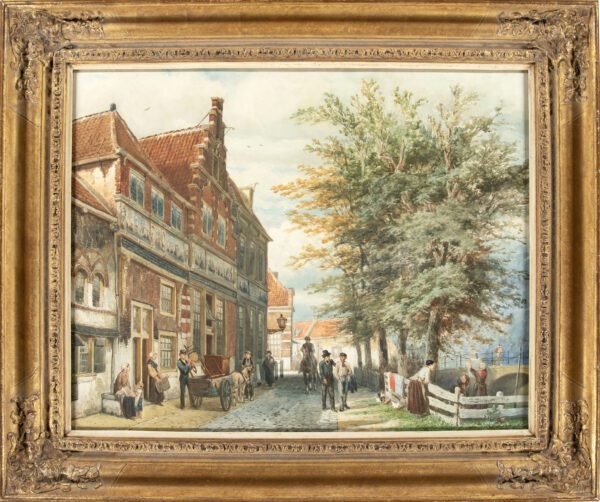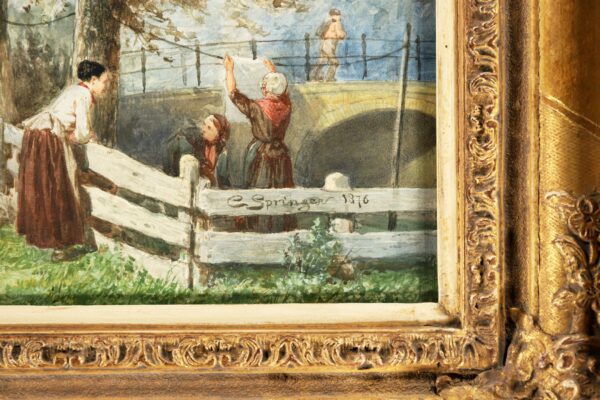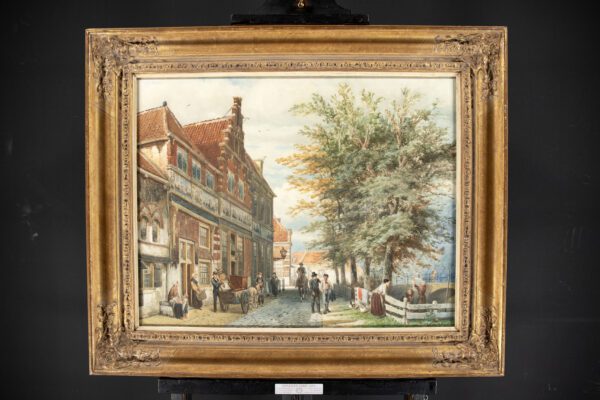“De Huizen van Bossu, Hoorn”, 1876
Watercolour: 52 x 67 cm;
signed and dated ‘C Springer 1876’ (lower right)
"*" indicates required fields
Notes
The facade stones on the row of houses that are traditionally called ‘houses of Bossu’ remind us of the battle of the Zuiderzee in 1573, in which the Spanish Admiral Bossu was utterly defeated by the West Frysian ‘Watergeuzen’. The ‘Bossuhuizen’ are three adjacent houses on the Slapershaven in the West Frisian city of Hoorn.
Partly for this reason, the Duke of Alva failed to conquer North Holland. On the facade stones the West Frisians are depicted as the men of Israel as they fought against the Biblical warlord Amalek.
Cornelis Springer was a 19th-century Dutch artist and one of the most important Dutch cityscape painters; he has been called the “greatest painter among the architects, and the greatest architect among the painters”. Working within the tradition of 17th-century Dutch Golden Age painters such as Jan van der Heyden and Gerrit Berckheyde, Springer emphasized form and receding perspectival space through the play of light as it cuts across buildings.
Born on May 25, 1817 in Amsterdam, Netherlands, he went on to study at the Amsterdam Academy of Art, and then as a private pupil of Kasparus Karsen. He became a member of the Amsterdam painters collective Felix Meritis and won a gold medal for a painting of a church interior in 1847. He is known for watercolors, etchings, and drawings, especially of city views and town scenes that he sketched while traveling around the country. He was awarded the Leopold order of Belgium in 1865, and in 1878 he was invited with Jozef Israëls to advise the Dutch Ministry of Public Affairs on the plans for the Rijksmuseum. Together with B.C. Koekkoek and A. Schelfhout, he belongs to the leading painters of Dutch Romanticism.
The artist died on February 20, 1891 in Hilversum, Netherlands. Today, his works are in the collections of the Museum of Fine Arts in Boston, the Rijksmuseum in Amsterdam, the Philadelphia Museum of Art, the Cheltenham Art Gallery & Museum, and the Teylers Museum in Haarlem, among others.
Provenance
- Amsterdam, Fred. Muller, studio sale Cornelis Springer, December 1891, no. 178;
- Collection B. de Geus van den Heuvel, Nieuwersluis;
- sale Amsterdam, Sotheby Mak van Waay, ‘Collectie B. de Geus van den Heuvel’ April 1976;
- Private collection, The Netherlands.
Literature
- Laanstra, H.C. de Bruijn, Dr. J.H.A. Ringeling, ‘Cornelis Springer’, Utrecht 1984. no. 76-A-5;
- Laanstra, Cornelis Springer, ‘Geschilderde Steden’, Amsterdam 1994, p.80, ill. for reference: no.75-12, is a version in oil;
- Laanstra, ‘Cornelis Springer, Geschilderde Steden’, p. 78, is a drawing.
Exhibitions
- Schiedam, Stedelijk Museum, Dec. 1951-Jan. 1952, no. 73;
- Enkhuizen, Zuiderzeemuseum, 1952;
- Amsterdam, Museum Willet Holthuysen, Romantische School, Nov.1958 – Feb.1959, cat. B-56;
- Laren, Singer Museum, Keuze uit de collectie B. de Geus van den Heuvel, no. 42
- Hoorn, Westfries Museum, Cornelis Springer in Hoorn, 10 Sept.-3 Nov. 1992.







